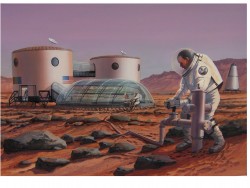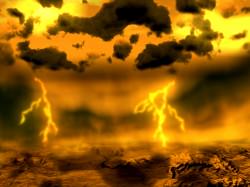Life on Earth got you down? Thinking you’d like to pick up and move to another planet? I’ve got bad news for you. Without protection, there’s no place in the entire Solar System that wouldn’t kill you in few seconds.
You’re looking at scorching temperatures, poisonous atmospheres, crushing gravity, bone chilling cold, a complete lack of oxygen, killer radiation, and more.
The entire Solar System is hostile to life as we know it.
If we had to choose from a range of terrible options, what would be the most Earthlike place in the Solar System?
We would want a world that has a similar gravity, similar atmospheric pressure and composition, protection from radiation, and a comfortable temperature. Just like the Earth.
Let’s look at a few candidates:
The Moon looks good. It’s close and… well, it’s close. It’s an airless world, so you’d need a spacesuit. Low gravity is bad news for your bones, which will lose mass and become brittle. Temperatures range from freezing cold to scorching hot, and there’s no atmosphere or significant magnetic field to protect you from the radiation of space.
While we’re suggesting moons, how about Titan, Saturn’s largest Moon?
It’s only 15% of Earth’s gravity, and the temperatures dip down to minus -179 degrees C; cold enough that it rains liquid methane. Even though the atmosphere is unbreathable, the good news is that the pressure is only a little higher than Earth’s. Which means you wouldn’t need a pressurized spacesuit, just a really, really warm coat.

The gravity of Mars is only 38% the gravity of Earth; and we don’t know what effect a long stay in this gravity would have on the human body. The atmosphere is poisonous carbon dioxide, and the pressure is less than 1% of sea level on Earth. So, you’d better pack a spacesuit. The temperatures can rise as high as a comfortable 35 degrees C, but then plunge down to -143 degrees C at the poles. One big problem with Mars is a total lack of magnetosphere. Radiation from space would be a constant hazard for anyone on the surface of the planet.

On the surface, it’s right out of the running. The temperature is an oven-like 462 degrees C, with a surface pressure 92 times more than Earth. The atmosphere is almost entirely carbon dioxide, with clouds of sulphuric acid. On the plus side, it has gravity roughly similar to Earth, and a thick atmosphere that would protect you from radiation.
Unfortunately, you’d die faster on the surface of Venus than almost anywhere else in the Solar System.
But… there is a place on Venus that’s downright lovely.
Up in the clouds.

Amazingly, if you rise up through the clouds of Venus to an altitude of 50-60 kilometers, the atmospheric pressure and temperature are the same as on Earth. The atmosphere would still be toxic carbon dioxide, but breathable air would be a “lifting gas” on Venus. You could float around the skies of Venus in a balloon made of breathable air. Stand out on the deck of your Venusian sky city in shorts and a T-shirt, soaking up the sunlight in regular Earth gravity.
Sounds idyllic, right?
So, opinions will vary. Some think Mars is the most Earthlike place in the Solar System, but in my opinion, the clouds of Venus are the place to go.
I’ll see you there.
Related Sources
Colonization of Venus
MarsOne Mission
Pros and Cons of Colonizing the Moon


I’ll meet you in the Venusian clouds, Fraser!
Just make sure your balloon would be acid-resistant.
I always wonder why not go underground in these planets like the doomsday preppers
I believe the temperature a few meters below earth stays a constant warm value as heat from the core works its way up and out. If this is true (and I’m not sure that it is) wouldn’t that mean the best place to be on the Moon Mars and Titan is a few meters underground? (and why are Earthian caves so chilly?)
See: Cave Meteorology.
That is very interesting, thanks. The geothermal gradient on earth is smaller than I thought, 1 F per 70 feet. I wonder if the gradients of other worlds can be estimated from current models?
I wouldn’t think so, but if it’s possible, IVAN3MAN will provide the appropriate link(s). I’m too lazy to do the research. ;- )
According to this (PDF) paper, which asks the question, “Are Earth Caves Good Extraterrestrial Analogs?”, it states:
A correction, if I may:
Carbon dioxide is no more “poisonous” or “toxic” than nitrogen. It is odorless, tasteless, and very much NON-toxic. It does not displace O2 in one’s system as carbon monoxide does, and it takes quite a bit of it mixed with water to make anything like a strong acid.
Granted, we aren’t plants, so breathing it INSTEAD of O2 isn’t wise. You would suffocate in a 100% CO2 atmosphere, just as you would in a 100% N2 atmosphere. But provided enough O2 is mixed in (and provided it IS CO2, not carbonic acid post-mixing with water vapor), the gas won’t “poison” you, or otherwise cause you any distress.
I see your point but breathing just 5% CO2 will kill you while breathing lots of N2 is safe, assuming in both cases there’s 20% O2.
On one hand, using this rationale allows one to say that just about ANY gas could be considered “toxic” above a certain amount. But on the other hand, 5%+ CO2 will eventually lower the ph of your blood to dangerous levels, and you won’t be very comfortable while it’s happening since your breathing is regulated by CO2 pressure in the bloodstream (not O2 as most people think).
But since we ARE talking about atmospheres well over the 5% CO2 level, I think it’s fair to admit your point, Phil. Perhaps a compromise along the lines of “what is normally a non-toxic trace gas on Earth becomes poisonous at levels well below the higher concentrations found on Venus…” ^_^
I’m not sure that I’d like to live in Venus’ upper atmosphere, despite the pleasant temperatures. The winds whip around at 300km/hr and carry much more force than Earth’s winds because of the increased pressure (although, I acknowledge that you are talking about living in the upper atmosphere, where the pressure would be greatly reduced). These are regular winds and not storms or gusts. These kinds of winds on Earth are utterly destructive and usually associated with the worst storms. Imagine living in this kind of wind as part of your daily routine? I get seasick just thinking about it. I’m also not partial to sulfuric acid.
My vote is for Mars. Yes, there’s bad radiation, but I’d rather go with lack of pressure and cold temperatures than with extreme heat, killer acid and violent winds (I always prefer winter to summer). I’m thinking that a huge, nuclear powered magnetic field would deal with the issue of radiation on Mars. A giant biodome would help address the pressure issue. As for lack of gravity, I’d rather my bones adjust to low gravity than be broken while living in a bubble in Venus’ atmosphere while bumping around at 300km/hr!
Generating a magnetic field on Mars…. I’ve often wondered if there might be a way we could somehow enhance and use existing magnetic anomalies on Mars? – http://www.princeton.edu/geosciences/people/simons/pdf/LPSC-2011.pdf – The MER Opportunity found one large NiFe meteor on it’s trek to Endeavour Crater. – http://www.universetoday.com/36498/opportunity-spies-unusual-rock-large-meteorite/ – Indicating there are probably many more laying on the surface waiting to be collected? How about… We collect those NiFe meteorites, melt them down and forge components for a very large geodesic dome structure? Locate the well grounded dome in an area of enhanced magnetic field strength – say above a buried giant metallic meteor remnant? Solar panels on the appropriate ‘great circles’ of the geodesic and collected tribo electric energy would then be used to charge the dome’s metallic shape and connect it to the buried magnetic structure.
Bonus.. a sealed dome could be pressurized and would provide space for a greenhouse and other habitat.
Good thinking. I envision an autonomous robot that has the ability to melt down these meteorites and “print” them into a structure long before humans show up. Maybe also a robot to make the solar panels by melting down and “printing” silicon solar cells (I don’t know enough about the process to know if this is even feasible, but one can dream).
Now, if I could only find billions and billions of dollars to make this happen, we’d be there!
My advice is to skip planets and moons altogether. Outside of maybe some small research outposts I think planets are impossible places to colonize with large numbers of people. There is also considerable energy investment in getting on or off these bodies due to gravity. The interest in asteroids is probably the direction to go. Of course it will be a long time before this can happen, but potentially in a century we may be able to process all the materials of an asteroid. Some of it could be shipped back to Earth. Clearly there has to be some economic feedback for doing this. The other materials that are processed that have little commercial value on Earth could then be fabricated into a large sphere or cylinder.
Much of an asteroid is basically rock, iron, carbon and so forth, depending on the type of asteroid. An asteroid with a volume (4?/3)r^3 (the physics trick of assuming a spherical cow) could be made into spherical shell or radius R and a thickness of d = ?R << R. Let us assume the asteroid is 10km in radius and we want to make a spherical shell with surface area A = 4?R^2 and a shell thickness of 10m. This means we can then find the radius of the shell by
4?R^2d = (4?/3)r^3
and the radius by elementary algebra is R = sqrt{r^3/3d} = 182km. This has an internal surface area of 4.2×10^5km^2. Of course maybe only half of this is usable, since the area near the axis of rotation is too steep, of this is maybe a total living area of 200,000sq km or 75,000sq mi. This is land area slightly greater than Ireland and smaller than the Czech Republic. It is not expansive, but it could be comfortable. Several million people could live inside this rotating shell with a reasonable degree of comfort. Since there are around 10^4 asteroids of this size it means there is potential living space for 10 to 20 billion people. There are about 1000 asteroids of 30km in radius and each of these could provide living space for 10-20 million people or so, giving living space for up to 10-20 billion. There are of course options for smaller asteroids. 1km asteroids could provide the space equal to a metropolitan area which could house 10^5 people or so. There are enough to hold maybe 10 billion people. It is then possible in this way to provide living space for maybe up to 50 or even 100 billion people.
Of course it is a huge proposition to suppose this can possibly happen. It is very unlikely that we can alleviate our current population pressures on Earth this way. It also requires there to be some economic need for an ever expanded presence in space. The only step I can see right now we could maybe take in this direction might be solar power satellite stations in geosynchronous orbit. Beyond that maybe asteroid mining later in the 21st century will be the next step, so that by the 22nd or 23rd centuries humanity might begin to seriously colonize the solar system this way.
LC